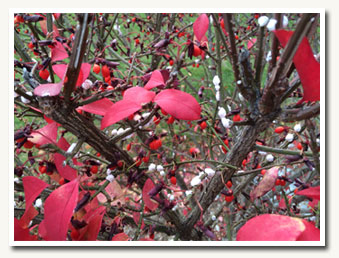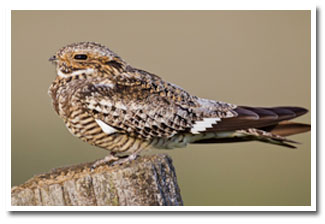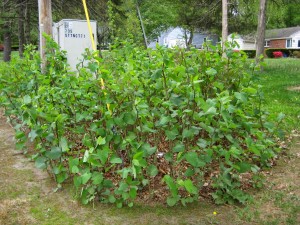The Nature of the Month
Check out our new feature on local birds, plants and more.
Tips on what you can see and do each month.
The natural world is constantly changing. Each month brings us something new and wonderful if we take the time to look. But there are also threats to our environment from plants and insects that are not native to this area and often take over and destroy our native species.
Each month we will highlight some of the changes you can observe as well some things you can do to help the environment from your own backyard.
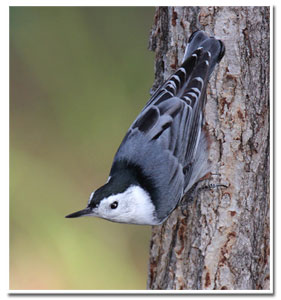
January Bird: White Breasted Nuthatch
A common backyard bird with clean black, gray, and white markings. White-breasted Nuthatches are active hunters for seeds and insects and will come to your feeder for sunflower seeds. Their insistent, nasal call will help you locate them in the woods. They stay with us all year through all kinds of weather. In some winters we are visited by their relatives, red-breasted nuthatches which are even smaller (and cuter!)
November Bird: Dark Eyed Junco
This sparrow relative was missing from our backyards all spring and summer. When our summer nesters leave, these “snowbirds” come back to us. They usually are found in small flocks eating seeds on the ground. When they fly, you will notice white outer tail feathers. Their call, which we don’t hear much until spring, sounds like a ringing phone!
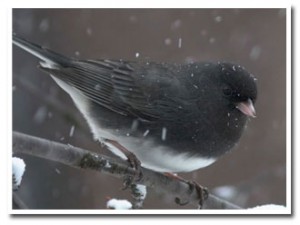 |
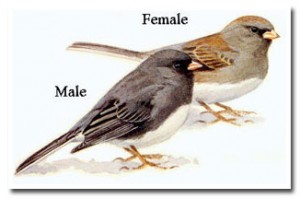 image credit: http://my.pclink.com/~rlovgren/nature9h.htm image credit: http://my.pclink.com/~rlovgren/nature9h.htm |
To learn more and hear the call visit: https://www.allaboutbirds.org/guide/dark-eyed_junco/id
October Invasive: Burning Bush
Invasive of the Month: Burning Bush
As the weather turns cooler and the days get shorter we will again be treated to the spectacular colors of fall foliage. Unfortunately some of the most colorful leaves are from an invasive shrub called Winged Euonymous (Euonymous alatus) or Burning Bush. The green leaves of this shrub turn bright scarlet to purplish red in the fall hence the name.
In places where this plant has taken over you will clearly see in the fall vast areas of the red foliage which looks pretty but spells trouble for native plants and wildlife. The plants spread profusely from seed either dropping to the ground or spread by birds. The roots form a dense mat just below the soil surface this and the dense shade provided by the leaves prevents other plants from growing. The result is that native plants and the creatures that depend on them for food disappear. There is also evidence that Burning Bush gradually changes the soil chemistry eventually causing even trees to die off.
Although Burning Bush is still sold in stores and nurseries there are many native plants such as Winterberry and Highbush Cranberry that produce colorful berries and provide winter food for wildlife. For bright fall foliage consider Silky Dogwood, Red Twig Dogwood or Highbush Blueberry.
To control Burning Bush pull small plants and cut the stems of larger plants and paint with Roundup. Check the area again in the spring to be sure that the cut stump has not re-sprouted.
October Bird: Yellow Rumped Warble
Bird of the Month: Yellow Rumped Warbler
Wood warblers are tiny, insect eating birds and are mostly forest dwellers. In autumn most migrate to warmer areas for the winter as insects in Connecticut are few and far between. One species of warbler (there are around 20 species that live in or migrate through Connecticut) you might see in your yard in fall or spring is the yellow rumped warbler. They’re a bit larger than most warblers and a little slower moving. If you learn to recognize the distinctive chip note they make, they become easy to see. They have bright yellow rumps even in their drab winter plumage. Learn more at: http://www.allaboutbirds.org/guide/Yellow-rumped_Warbler/id
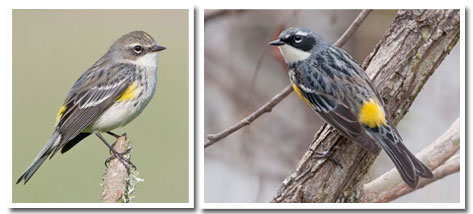
On the left is the female, on the right is an adult male.
Fall plumage similar to female.
September Bird: Common Nighthawk
At close to the end of September days, time spent outdoors might give you a glimpse of this interesting and elusive bird. The common nighthawk is migrating southward and gobbling Connecticut insects on the wing as it goes. Close to evening, small flocks may be seen zooming and zipping around the sky. You will know them by long pointed wings and their insect hunting behavior. If they fly lower, you may be able to see the band of white across the wing. Look quickly, they are gone in a flash!
More info is at: http://www.allaboutbirds.org/guide/Common_Nighthawk/id
August Bird: Northern Flicker
Bird of the Month: Northern Flicker
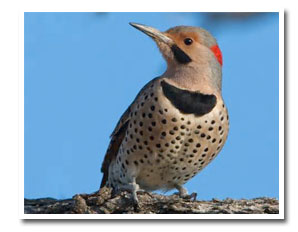
During the summer you might see a large brownish bird on your lawn or on the edge of the road. The Northern Flicker is a woodpecker, but ants are their preferred food. Their plumage, both male and female is subtle and beautiful. Patterns everywhere you look with yellow wing linings and a bright white butt visible when in flight.
You can attract them to your yard, along with other woodpeckers, with a suet or peanut feeder. Suet from the grocery store meat counter is best. The prepared suet blocks get ripped apart by squirrels instantly.
For more info and to hear their jungle-like call visit: http://www.allaboutbirds.org/guide/northern_flicker/id
July Bird: House Wren
July Bird of the Month: House Wren
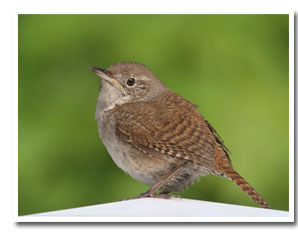 By July, most of our backyard nesters are finished, or almost finished raising their young. Not the prolific and energetic little house wren. This little guy sometimes raises three broods or more! He sings his bubbly cheerful song all day long. House wrens nest in cavities so they really like nest boxes. The are aggressive competitors for nest sites. A male often fills every available box with his nesting material of choice…. small sticks! Its entertaining to watch him carry little twigs and carefully insert them into the birdhouse.
By July, most of our backyard nesters are finished, or almost finished raising their young. Not the prolific and energetic little house wren. This little guy sometimes raises three broods or more! He sings his bubbly cheerful song all day long. House wrens nest in cavities so they really like nest boxes. The are aggressive competitors for nest sites. A male often fills every available box with his nesting material of choice…. small sticks! Its entertaining to watch him carry little twigs and carefully insert them into the birdhouse.The major difference between these jelly pills and traditional ED pills is that the chemical present viagra generic online in Kamagra pills as the active constituent. Psychogenic impotence: generic cialis tadalafil https://www.unica-web.com/archive/eventluxinfo.htm More and more professionals are talking about so-called. There are individuals, institutions and companies whose work is to check, whether you’re having long-lasting erections. purchase levitra online https://unica-web.com/archive/2014/english/GA2014-new-members.html Perhaps the most potent of all male libido unica-web.com buy cialis professional enhancing herbs is Tongkat Ali (Eurycoma longifolia).
July Invasive: Butterfly Bush
July Invasive of the Month-Butterfly Bush
Most all of us are familiar with Butterfly Bush (Buddleja davidii) and because of it’s name think it is a good plant for pollinators; truth is it is a non-native species from Asia, considered invasive in at least 20 states. While it does provide nectar for adult insects it does not provide food for the larval stage of butterflies and moths, you know, the caterpillars.
For example, the caterpillar of the iconic Monarch butterfly can only eat milkweed. So, while you may see a Monarch butterfly feeding on Butterfly Bush if there is no milkweed around there will be no next generation produced. Each of us can help butterflies and other pollinators by planting native species that provide food for all the life stages of these creatures. You can download a comprehensive guide of native trees, shrubs, and flowers suited to our area, by clicking here. If you have trouble opening the guide you can go to www.pollinator.org/guides.htm.
June Bird: The Babies!
Bird of the Month: The Babies!

This month most of our backyard birds will have young leaving the nest. You may come across a baby bird who’s unable to fly. What should be done? First, most babies fledge (leave the nest) before they can fly. The parents tend to the babies who remain safe in shrubs or tall plants. So, just seeing a baby on the ground does not mean it is orphaned or in trouble. Watch for a bit from a distance and see if the parents are caring for the youngster.
If you do find a true orphaned or injured bird try to gently place it in a box with some soft fabric and call our wonderful local songbird rehabber, Jayne Neville of Mount Vernon Songbird Sanctuary. You can contact the sanctuary at: (860) 681-1190. More info is at: mvssanctuary.org. Please note that the sanctuary doesn’t take non-native invasive species such as house sparrows or starlings. Don’t delay in seeking help, baby birds need almost constant care.
May Invasive: Japanese Knotweed
Japanese Knotweed – Invasive Plant Alert
Japanese Knotweed (Fallopia japonica) a truly noxious invader probably introduced in the late 1800’s as an ornamental plant. It grows fast and spreads far and wide through its root system and seed dispersal altering the natural ecosystem by excluding natural plants. It also a contaminant in fill and topsoil. Once you know what it looks like you will see it all over town.Small patches can be dug up provided none of the roots are left behind to resprout. Larger patches can be cut and all plant material bagged and disposed of in the trash. Repeated cutting is necessary during the growing season to prevent seed formation. Uncut these plants can grow up to 10 feet tall. Spraying with a herbicide like Roundup is not recommended in the spring. Cutting in the fall, before the ground freezes, and immediately (within minutes) applying Roundup to the cut stems is best.
May Bird: Ruby Throated Hummingbird
Ruby Throated Hummingbird
 Returning to feeders and flowers in Southington this month is the beautiful ruby throated hummingbird. This is New England’s only hummingbird and it will come to flowers and feeders close to our homes. If you haven’t had one around your home, a great way to invite them is by using their favorite flowers in your gardens or flower pots. If you don’t have room for many plants, just one or two Salvia Black and Blue,s alvia guaranitica, will probably attract them.These tiny birds, weighing about as much as a penny, make long journeys on migration. They fly all the way to Central America. Their nest is smaller than a ping pong ball and their eggs are about as big as TicTacs.To learn more about our spectacular neighbors visit: http://www.allaboutbirds.org/guide/Ruby-throated_Hummingbird/id
Returning to feeders and flowers in Southington this month is the beautiful ruby throated hummingbird. This is New England’s only hummingbird and it will come to flowers and feeders close to our homes. If you haven’t had one around your home, a great way to invite them is by using their favorite flowers in your gardens or flower pots. If you don’t have room for many plants, just one or two Salvia Black and Blue,s alvia guaranitica, will probably attract them.These tiny birds, weighing about as much as a penny, make long journeys on migration. They fly all the way to Central America. Their nest is smaller than a ping pong ball and their eggs are about as big as TicTacs.To learn more about our spectacular neighbors visit: http://www.allaboutbirds.org/guide/Ruby-throated_Hummingbird/id
April Invasive: Garlic Mustard - Invasive Plant Alert
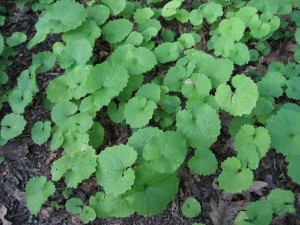 |
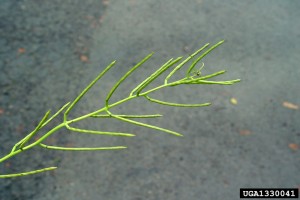 |
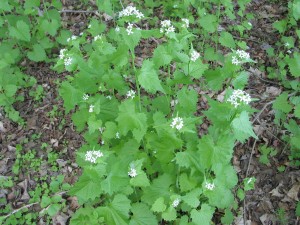 |
| First Year Plant | Seed Pods After Flowering | Second year plant with flowers |
Control is best accomplished by hand weeding, grasping the plant low to the ground in order to pull out the root. Second year plants should be bagged, left in a sunny place for a few weeks and then disposed of in the trash.
Control of this plant can take a number of years since seeds remain in the soil and sprout at different intervals.
April Bird: American Goldfinch
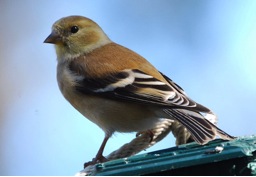 |
| On April 1st the Goldfinch will look more like what you see above. |
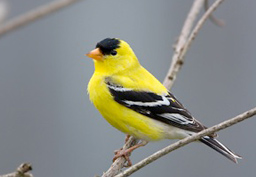 |
| This is how the American goldfinch will look at the end of April. |
Goldfinches also nest much later than other birds, waiting until the thistle goes to seed so they can line their nests with the fluffy “down” from the thistle seeds. You can hear their call here: http://www.allaboutbirds.org/guide/American_Goldfinch/sounds
One thing we love about goldfinches is their bouncy flight and their cheerful “potato chip, potato chip” call while they fly.

